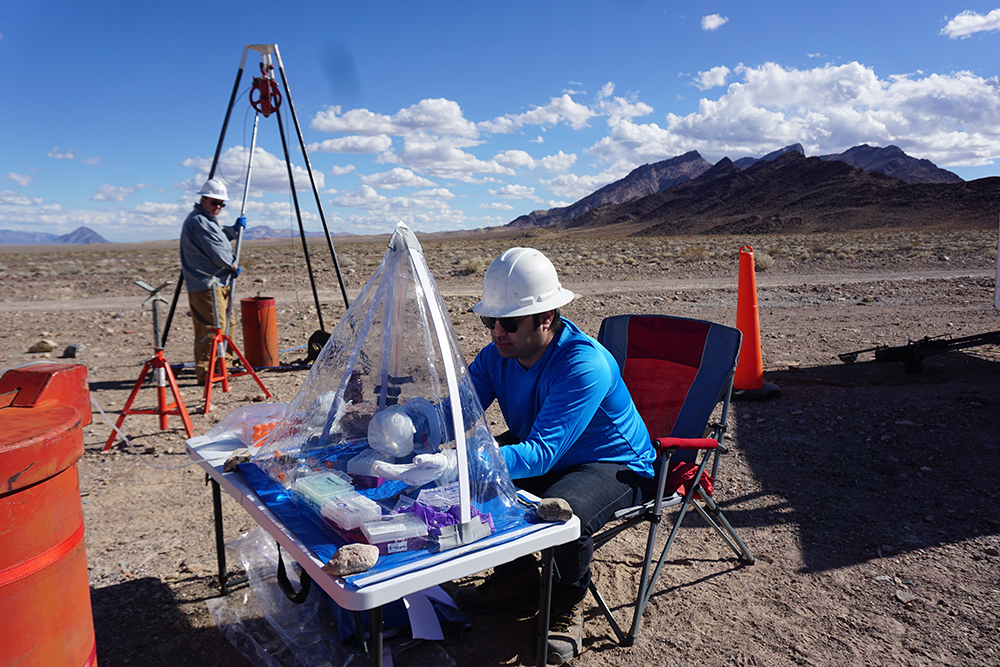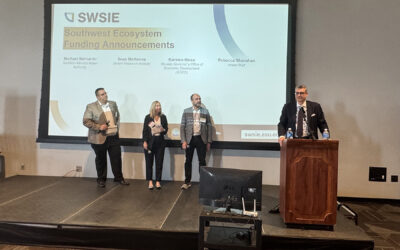Researchers have refined an innovative method for measuring the activity level of microbes and linking that to their individual genetic code, providing new insights into the microbial communities that thrive in extreme environments.
DRI’s Duane Moser, Ali Saidi-Mehrabad, and Molly Devlin co-authored a new study that examines the genetics and life strategies of microbes living deep below Earth’s surface. Dr. Moser and his lab conducted the fieldwork for the research as part of their work studying deep wells located in the Death Valley regional flow system. These extremely deep wells provide windows into subsurface environments, and their research has shown that one of them, Inyo-BLM1, contains several key microorganisms that are only found in the deepest South African gold mines. Very little research has illuminated the viability and respiration status of microbes living at this depth, and studies like this can not only help scientists understand life on Earth, but can also offer a glimpse of what life could look like on other planets.
“Some of the organisms from this study are identical at the species level to some of the deepest life ever detected at locations around the world,” said Moser. “But for the first time, because of unique single-cell genomics tools, we are able to identify active organisms at the scale of a single cell that respond to stimuli in near-real-time, helping us address questions about how deep life is able to persist in these isolated environments.”

The new study replicated an earlier ship-based mission led by Bigelow Lab focused on fluids below marine crusts, added Saidi-Mehrabad, but focused on a similar environment (e.g. hot and anerobic) in the deep continental subsurface. “Both projects were funded by NSF to refine and test a suite of cutting-edge technologies that expand upon traditional methods to enable us to study microbial activity at the level of the single cell,” he said. “The ongoing study here at DRI, which is going to complement our PNAS paper, will demonstrate how much the previous study has captured the temporal and spatial variation of the deep continental aquifer microbial community, including the viruses over time.” The research will also help our understanding of the global carbon cycle, he said.
“Linking microbial activity measurements to specific taxa is exciting because it allows us to better understand two key physiologies in deep subsurface environments, sulfate reduction and methanogenesis,” Devlin said. “Previously, we thought the abundant methane and presence of methanogens indicated biotic methanogenesis was taking place in this system, but the lack of activity measurements for suspected methanogens has led us to consider alternate origins for this methane.”
Read the full press release from Bigelow Lab below:
A team of scientists led by researchers at Bigelow Laboratory for Ocean Sciences have developed an innovative method to link the genetics and function of individual microbes living without oxygen deep below Earth’s surface. Measuring both of these attributes — and, more importantly, linking them together — has long been a challenge in microbiology but is critical for understanding the role of microbial communities in global processes like the carbon cycle.
The new approach, developed at Bigelow Laboratory’s Single Cell Genomics Center, enabled researchers to discover that one species of sulfate-consuming bacterium was not only the most abundant but also the most active organism in a groundwater aquifer beneath Death Valley, almost half a mile below the surface. The findings, published in the Proceedings of the National Academy of Sciences, show how this method can be a powerful tool for measuring how active different organisms are in these extreme environments.
“Previously, we had to assume that all cells were operating at the same rate, but now we can see that there is a wide range of activity levels between individual members of the microbial communities,” said Research Scientist and lead author on the paper Melody Lindsay. “That helps us understand what these microbial communities are capable of and how that might influence global biogeochemical cycles.”
The recent study is a part of a larger project linking the genetic code of microbes — the blueprint of what they’re capable of — to what they’re actually doing at any given moment.
Funded by NSF’s EPSCoR program, the “Genomes to Phenomes” project is a joint venture between Bigelow Laboratory, the Desert Research Institute, and the University of New Hampshire. It leverages recent advances in single-cell genetic sequencing with a creative approach applying flow cytometry to estimate the rates of processes, such as respiration, happening within those cells.
Flow cytometry, a method for analyzing individual environmental microbes that was adapted at Bigelow Laboratory from the biomedical sciences, allowed the researchers to quickly sort out living microbes in the aquifer water samples. Those microbes were stained with a specially designed compound that lights up under the flow cytometry laser when certain chemical reactions are happening within the cell. The relationship between how much the cell fluoresces under the laser and the rate of those reactions was worked out experimentally with lab-grown cultures of cells by student interns at Bigelow Laboratory and then applied to the Death Valley samples.
Once the active cells were measured and isolated, the team sequenced their individual genomes. The researchers also used meta-transcriptomics, a method for determining which genes are being actively expressed, as well as radioisotope tracers and stable isotope probing, more traditional methods for measuring activity within a microbial community. This was done both to “double check” their results and to get even more information on the links between what these microbes are genetically capable of and what they’re actually doing.
The Single Cell Genomics Center is the only analytical facility in the world offering this new technique to researchers.
“This study was an exciting opportunity for our research team and the SCGC to help improve our understanding of the immense, enigmatic microbial ecosystems underground,” said Bigelow Laboratory Senior Research Scientist Ramunas Stepanauskas, the director of SCGC and principal investigator of the project.
This new study builds on the first demonstration of this approach for quantifying the activity of individual cells. In late 2022, the team published findings on microbes in seawater, showing that a small fraction of microorganisms is responsible for consuming most of the oxygen in the ocean. With this new paper, the team is expanding that method to show it can be used in low-biomass environments with microbes that don’t rely on oxygen. In the samples drawn from the subsurface aquifer in California, for example, the scientists estimated that there were hundreds of cells per milliliter of water, compared to millions of cells in a typical milliliter of surface water.
“We started out with oxygen-respiring organisms in the ocean because they’re a little more active, a little easier to sort, and easier to grow in the lab,” Lindsay said. “But aerobic respiration is just one process that is possible in microbiology, so we wanted to branch out beyond that.”
The results confirmed that the bacterium Candidatus Desulforudis audaxviator was not only the most abundant microbe in this environment, but also the most active, reducing sulfate for energy. The overall activity rates the team measured were low compared to the seawater samples from the previous study, but there were large differences between how active individual microbes were.
“Some of the organisms from this study are identical at the species level to some of the deepest life ever detected at locations around the world,” said Duane Moser, an associate research professor at the Desert Research Institute and co-author on the study. “But for the first time, because of unique single-cell genomics tools, we are able to identify active organisms at the scale of a single cell that respond to stimuli in near-real-time, helping us address questions about how deep life is able to persist in these isolated environments.”
The research team is now working to apply their method to measure other anaerobic reactions, such as nitrate reduction, and to new environments, including sediments along Maine’s coast. A related project funded by NASA is also enabling Lindsay and her colleagues to test the method in the deep subsurface below the ocean.
“Right now, we’re getting all of these point measurements around the world, and they do help us better understand what microbes are up to, but we need to scale it up,” Lindsay said. “So, we’re thinking about how to apply this method in new places, even potentially on other planets, in expanded ways.”


